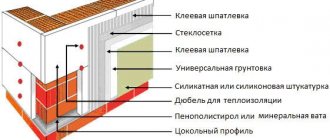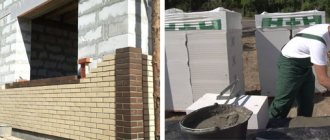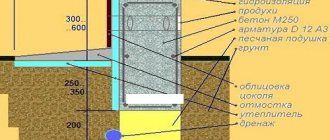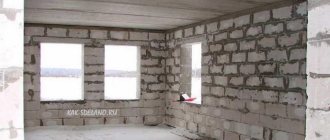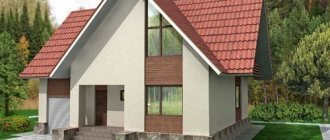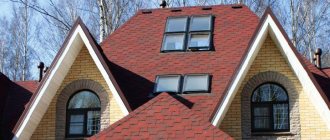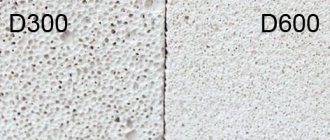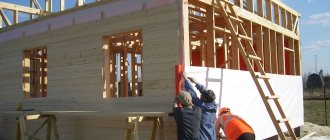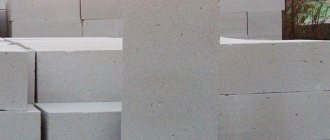Is aerated concrete harmful to human health?
Aerated concrete is a relatively new material, but it is most often chosen for the construction of private houses and for creating interior walls in high-rise buildings.
The issue of environmental safety is the number one issue. So is aerated concrete safe? The material is a type of cellular concrete. Special additives cause concrete to foam during the production process. This foam is fine-celled and hardens quickly, forming a durable and solid monolith. Foamed concrete is cut into large blocks, which are called gas blocks.
Many people are still wary of aerated concrete. The material has not yet stood the test of time. The low price also makes you wonder whether everything is in order with the composition of the material, because according to the prevailing belief in society, “cheap is never good.”
But on the other hand, if this material were harmful to humans, then it would not have received such widespread use in Western European countries (there are very strict sanitary and environmental requirements for building materials).
Supplements
Concrete contains a small amount of additives. Information has repeatedly appeared that they cause health problems. What is it really{q} Not a single large plant will use prohibited and harmful substances for the production of concrete. All products undergo careful control; there are standards and requirements for materials, so no company will allow itself to use prohibited and hazardous additives. This will not only damage her reputation, but may also result in huge fines and the initiation of a criminal case.
We suggest you read: Sample of writing a complaint against a neighbor to the administration
Even after hardening, concrete is completely safe. It does not release harmful substances into the environment and does not harm health in any way. But what about the numerous diseases that cripple young and old people{q} It’s definitely not worth linking this with concrete. People have been living in such buildings since ancient times, and to say that it is the cause of terrible diseases is, at a minimum, incorrect.
The only true feature of this material is that during hardening, dry air appears. During the hardening process, concrete takes moisture from the environment, but even this cannot harm a person. Within a month after pouring the concrete solution for the foundation, for example, the process of “absorbing” moisture will end and you can enjoy fresh air.
Advantages and disadvantages of aerated concrete
Advantages of aerated concrete:
- Keeps warm well;
- Incombustible;
- Easy to process;
- Has fairly high strength;
- Aerated blocks are light in weight and large in size, which greatly speeds up construction;
- The price of aerated blocks is relatively low and the cost of installation work is lower than that of brick, for example. In addition, the material is quite light, so the foundation for such a house can be lightweight;
- It has good vapor permeability, aerated concrete “breathes”, which allows you to create and maintain a comfortable microclimate at home.
Disadvantages of aerated concrete:
- Absorbs moisture due to its open porous structure, so the walls must be plastered or covered with another material;
- The blocks are connected with glue, and not with ordinary mortar; glue is more expensive;
- Increased fragility - foundation subsidence is unacceptable, multi-story construction from aerated concrete alone is impossible.
And the most important issue is environmental friendliness. How harmless is aerated concrete? Can we confidently consider the environmental friendliness of aerated concrete blocks as an advantage, as manufacturers claim?
To understand whether aerated concrete is harmful to health or not, you need to know not only its components, but also what happens to them during the production process.
What are aerated blocks made from?
Aerated concrete is produced by mixing cement, a fine fraction of quartz sand, quicklime, water and aluminum powder in specially selected proportions. Also, ash and ground slag can be added to the composition of aerated concrete.
- Cement is the main binding component included in any concrete. It's safe.
- Quartz sand. A natural material, it is mined in quarries and is part of other building materials.
- Gypsum is added as a binding material, it is harmless, it is used both in medicine and for interior decoration;
- Aluminum powder - needed for foaming concrete. It is known to everyone as silver paint. As a result of a chemical reaction, it is converted to aluminum oxide.
- Lime is another safe component; it was previously used for whitewashing in residential areas.
- Slag and ash are not essential components of aerated concrete, but depending on the technology, they may be present in it as a filler.
How are aerated blocks produced?
After mixing, the components of the resulting mixture enter into a chemical reaction with the release of gas - hydrogen. Gas release is accompanied by the process of hardening (hydration) of the concrete mixture with an increase in its volume by 1.5...2 times.
The hardened mass is removed from the molds and cut into blocks of the specified size.
After this, the material is placed in an autoclave to increase its strength to process the aerated concrete at elevated temperatures and pressures. In this case, the remaining aluminum powder is converted into aluminum oxide.
Aerated concrete is a material that is produced only in factory conditions. It is impossible to produce this material in artisanal conditions in large quantities. Production of aerated concrete in a factory has its advantages:
- The dimensions of the blocks are strictly maintained;
- quality control of products is carried out at all stages of aerated concrete production;
Concrete is a reliable and proven material over the years.
These are not just words. This material has been used in construction for a long time. It underwent multiple tests, which showed that concrete does not emit harmful substances and does not have a negative impact on human health. Manufacturers of this material do not violate technology and do not use harmful additives, and this is an indisputable fact. All statements about the dangers of concrete are a myth. Of course, if it is not produced in a handicraft way.
Concrete is widely used in construction. This material has undergone multiple tests, the results of which will convince pragmatic customers. The manufacturer does not use harmful additives, and also conducts additional laboratory tests. So you don’t have to worry about technology violations or possible troubles after the work is completed.
We suggest you read: How is alimony calculated if a person does not work?
The dangers of concrete are a myth. The building material has been tested in practice by families living in monolithic houses. They feel great, enjoying the comfort and reliability of buildings. Discussion of low-quality components appearing due to small manufacturers using artisanal methods. They have no quality guarantees, so you should be careful when ordering.
Environmental friendliness of aerated concrete
Aluminum powder is something that causes concern. But, firstly, there is very little of it (only 400 grams per cubic meter of raw materials). And secondly, as a result of a chemical reaction, this substance is converted into aluminum oxide and hydrogen. Hydrogen is a gas present in the air we breathe, and it causes concrete to swell. And aluminum oxide is an absolutely safe compound that you encounter every day if you have an aluminum pan in your house, for example. This is that dark film of oxidation that covers all aluminum cookware over time.
Aluminum compounds are also found in traditional building materials. For example, in clay and, accordingly, in brick there is several times more of it than aerated concrete blocks contain, but brick is considered an absolutely harmless material.
It should be noted that ordinary aerated concrete does not contain slag and ash, but, nevertheless, they can be added during the technological process to improve physical and chemical properties and reduce the cost of production. Ash from thermal power plant filters and ground slag are used to partially replace sand, which makes the mass more plastic, and ultimately the gas block will be stronger. But these additives may pose some danger to human health. They often contain heavy metals: cadmium, chromium, lead, copper. Radioactivity may also be increased.
It is very important that the manufacturer and supplier have a complete list of accompanying documents certifying the quality and safety of the product. These include: certificates of compliance with GOST, sanitary and hygienic conclusions, and so on.
It should also be noted that, depending on the region, in many cases it is more profitable for gas block manufacturers to buy fine-grained sand than ash from thermal power plant filters or metallurgical waste of the required quality. Therefore, they do not use additives and produce completely safe aerated concrete.
Another advantage in favor of the environmental friendliness of aerated concrete is that recycling the material does not harm nature. Debris and construction debris crumble and disintegrate when exposed to moisture. Cement, lime and sand do not harm the soil. Moreover, you can find publications that advise adding aerated concrete chips, along with brick chips, as a leavening agent on heavy, waterlogged soils.
Conclusions . Aerated concrete can be considered a building material that is safe for human health.
It can become dangerous only if the standards are not followed and prohibited additives are used. Therefore, it is necessary to purchase gas blocks from certified manufacturers. Yes, the price will be a little higher, but you can be sure that all components have undergone radiological and toxicological testing before entering the solution.
Material composition and component properties
The structural structure is as follows:
- cement is a binder. Used pure or with lime;
- river sand – filler;
- aluminum paste is all that remains after the pore-forming reagent.
We suggest you read: Is it possible for the owner to discharge a temporarily registered person ahead of schedule
? There are types of aerated concrete blocks, for the production of which slag and ash are additionally used.
To understand whether aerated concrete is harmful to health or not, you need to know not only its components, but also what happens to them during the production process.
The photo shows the main ingredients of aerated concrete
- Cement is the main binding component included in any concrete. It can only be harmful in its original granular state (more on that a little later), but as part of ready-made blocks or solutions it is completely safe.
- Quartz sand. Natural natural material, to which there should be no questions. However, like any rock, it can theoretically contain radioactive substances. But the use of such raw materials is prohibited and carefully controlled. If the manufacturer has sanitary and hygienic certificates and quality certificates, there is nothing to worry about.
- Aluminum powder is exactly the chemical with which your friends most likely scared you, saying that aerated concrete is harmful to health. It is responsible for gas formation and the creation of the porous structure of the material. But, firstly, there is very little of it (only 400 grams per cubic meter of raw materials). And secondly, as a result of a chemical reaction, this substance is converted into aluminum oxide and hydrogen. Hydrogen is a gas present in the air we breathe, and it causes concrete to swell. And aluminum oxide is an absolutely safe compound.
Aluminum powder is the well-known “silver”
- Lime is another component of this building material, which is converted during the production process into a stable compound, potassium silicate. But in itself it does not pose a danger, otherwise it would not be used for whitewashing in residential premises.
- Slag and ash are not necessary components of aerated concrete, but they can be present in it as a filler. And only they can “spoil” aerated concrete - radioactive substances and heavy metals: lead, cadmium, etc. are harmful to health. Returning to what was said above, we recommend that when purchasing blocks you do not rely on the conscience of manufacturers, but require accompanying documents confirming the safety and quality of the products.
As you can see, aerated concrete and foam concrete cannot cause harm to health if they are made using standard technology from pure raw materials. Therefore, you should buy them from reliable manufacturers.
Aerated concrete blocks are harmful to health: truth and myths
Analyzing data on porous building materials, it is possible to come across the conclusion that aerated concrete is harmful to health. It goes without saying that the easiest thing to do is to dismiss such statements as idle fiction, but it is still better to analyze the composition and take into account all the possible risks.
We will devote our article to this issue.
Is aerated concrete harmful to health? | Questions and answers on the Nedvio website
Question from a reader of our portal: Is aerated concrete harmful to health?
Answer: No, it is not. Aerated concrete is an environmentally friendly building material and is harmless to human health, as it does not contain any harmful impurities or substances.
Aerated concrete is a type of porous (cellular) concrete, in the production of which only natural materials are used: cement, quartz sand, lime, and special gas-forming additives. The main gas-forming agent, as a rule, is aluminum powder, which during the manufacturing process increases the volume of the raw mixture several times.
This material has quite unique characteristics. The porosity of the aerated block structure helps to increase the thermal properties of the material, with a low level of thermal conductivity. But at the same time, the higher the porosity of the material and the higher the level of thermal conductivity, the lower the strength index.
Aerated concrete blocks have very precise planar characteristics and allow installation with a joint thickness of 2 to 5 mm, reducing heat loss between the joints. The porous structure of this material contributes to its saturation with water, which in turn increases the level of frost resistance.
In addition, gas blocks can easily be processed with various types of tools - electric saws, hacksaw blades, etc. Gas blocks can be easily sawed and drilled, and if necessary, even nails can be driven into them. This building material is classified as durable concrete, which has climatic characteristics that are inherent in wooden structures, which in turn helps to create an optimal indoor microclimate. One gas block replaces 16 bricks.
Thanks to their high level of sound insulation, aerated concrete blocks are now widely used for finishing wall surfaces; in addition, the material ranks first in terms of fire resistance and corrosion resistance.
Aerated concrete blocks are used in the construction of low-rise buildings, mainly for the construction of any internal partitions, and also as a filler for inter-frame spaces in the construction of high-rise frame structures. Most often, aerated concrete blocks are used in the construction of private cottages and summer houses, since such blocks are easy to process and lay.
Did you find this article helpful? Please share it on social networks: Don't forget to bookmark the Nedvio website. Useful articles and tips on construction, renovation, real estate every day!
Analysis of aerated concrete
To find out whether aerated concrete is harmful to health, it is necessary to analyze its composition and production technology:
- The base material is cement mortar with the addition of sand and lime.
- During the preparation of the solution, granular or paste-like gas-forming additives are introduced into the cement-sand mixture. Reacting with water, the aluminum component of these additives releases gas, which forms a system of pores in the material.
- To improve the mechanical properties of aerated concrete, slag or ash can be added to it.
- Upon completion of the reaction, the mixture is first subjected to primary hardening when heated, after which the finished blocks are sawn and autoclaved, treating them with heated steam.
In fact, other cellular concretes are produced using a similar scheme.
Indeed, there are differences in technological processes:
- For example, to make foam concrete, instead of an aluminum composition, a synthetic or protein foaming agent is added to the solution.
- And in the production of polystyrene concrete, the cellular structure of the material is formed by polymer granules, which are made from waste construction or packaging foam..
It goes without saying that the instructions for making these materials contain many other nuances that are not mentioned here, but we are primarily interested in the composition. Now we will try to analyze which specific components of aerated concrete can affect human health.
Is it harmful or not?
For good health
The negative effect of the material in most cases is divided into two aspects:
- Risk of human poisoning during interaction or long stay in the room.
- Destructive influence on the external environment.
We will try to consider both aspects in sufficient detail, and we will start with the one that is “closer to the body.”
So, is aerated concrete harmful to health?
- First, you need to pay attention to the base. Cement and sand, which are in a bound state, do not affect our body in any way. So there is definitely nothing to fear here.
- Lime also does not raise any questions in most cases, especially since at the end of autoclaving, virtually all of it goes into an inert state.
Note! Materials with a high lime content are significantly hygroscopic, so they should be protected from contact with water. But, this is only relevant for situations when we pour cellular concrete with our own hands: industrial designs in most cases do not have this drawback.
- Then there are gas-forming additives, which, in fact, are considered one of the risk factors. But here everything is in order: firstly, the aluminum that supplies the gas is non-toxic, and secondly, simple hydrogen is released during the hydration reaction.
- We still have additives, and this is where we need to be careful. The whole point is that both ash and slag can have very different origins, and therefore it cannot be ruled out that they contain heavy metals and toxins (lead, arsenic, etc.). It goes without saying that their part in the material will be negligible, but in any case this must be avoided.
- The way out of the situation is quite simple: you need to buy gas blocks from certified manufacturers. Yes, the price will be a little higher, but you can be sure that all components have undergone radiological and toxicological diagnostics before entering the solution.
In addition, it is worth saying a few words about other types of porous concrete:
- Foam concrete does not contain anything that can have a negative effect on our body.
- But the question of whether polystyrene concrete is harmful to health is quite complex. The material itself is completely reliable, but with strong heating there is a risk that the polystyrene granules will begin to melt, releasing toxic gas. But, this material belongs to the category of non-flammable, therefore the risk of such a situation occurring is minimal.
In addition, we must not forget that the open pores of such materials can be colonized by fungi or pathogenic microbes. To avoid this, you need to maintain a minimum level of moisture in the masonry, but here it is enough to follow the technology of construction and finishing of structures.
For the external environment
It is worth separately discussing the effect of the material on the external environment. Here the radiation characteristics of concrete come into play.
Note! You should not be afraid of the word “radiation” in the permitted context. In addition, the natural composition itself has a natural background: it is due to the presence of trace amounts of elements such as radium, thorium, potassium, etc.
It is possible to compare the radiation hazard of various building materials using the table:
Is aerated concrete harmful to health: the influence of slag and aluminum
Aerated concrete is increasingly gaining space in the construction market. It is lightweight, easy to use, installation in blocks occurs quickly, which saves time and, accordingly, finances; it is probably impossible to find a material with such low thermal conductivity indicators.
A house made of aerated concrete blocks - is there any harm to the health of the residents?
But today, more than ever, the issue of ecological housing is becoming relevant.
We try to surround ourselves with objects made from natural materials, and the choice of building materials is also subject to increased demands. The health of our children and ourselves will depend on this.
There are regulatory documents that set out certain requirements. These requirements must be observed when designing houses of various kinds and when choosing building materials. For the construction of residential buildings, office and industrial premises, materials that meet all standards must be used. It is these standards that aerated concrete must meet. Does such material harm our health, from what components and what technologies are used in its production? Such questions concern consumers.
Is there any harm?
The saying that only wooden houses are safe is not entirely correct. Knowing nothing about aerated concrete, the idea was that it is a material made from aluminum and lime, and it is unknown how it will affect health. Of course, both aluminum and lime itself are unsafe in normal use. In response to skeptics, we can say that we use aluminum cookware; for quite a long time the same lime was used for interior decoration. Let's try to understand the technology for manufacturing gas silicate.
Features of the production of aerated concrete blocks
To produce aerated concrete, four components are taken, these are mineral components: Portland cement, fine quartz sand, water, aluminum, lime. Porosity is formed as a result of a chemical reaction; aluminum (powder) is used as a gas generator. Hydrogen released during the reaction swells the solution. Thus, aluminum oxide appears. At this time, the mixture increases in volume due to the appearance of empty cells.
Aerated concrete production technology
For a material to become strong, it needs to harden. Manufacturers use two methods in which the material hardens:
- Autoclave method, the material is placed in a device where it is processed with high pressure and steam.
- Non-autoclave method, processing occurs only with high pressure.
As you know, the safest for health is aluminum oxide. If we compare aerated concrete with brick, the latter contains almost 8 times more aluminum. Its share in aerated concrete is 0.1%. As for lime, the reaction turns it into potassium silicate.
The material is also fireproof, as tests have shown. The radiation background, which is present in all materials, does not exceed the required value. Thus, it is significantly lower than that of reinforced concrete products.
Do aerated concrete walls affect the humidity level inside the house? Aerated concrete will absorb moisture at high humidity and only if the walls are not lined. The surface of walls made of any material must be primed, plastered or lined. You can look at the finishing of walls made of aerated concrete and the interior finishing of walls made of foam concrete in other articles on our website. The indoor humidity is affected by the ventilation and heating systems.
Sometimes unscrupulous manufacturers can add slag and ash to the aerated concrete mixture. They are the ones that can be dangerous, since they contain elements such as cadmium, lead, and copper. The radioactivity level may also change.
Recommendations
When purchasing building materials, it is recommended to check certificates of conformity, documents, and sanitary and hygienic certificates. And cheap material may not always be safe.
Certificates for Aerated Concrete Blocks Environmental friendliness of Aerated Concrete Blocks
Aerated concrete is one of the safest building materials after wood. During operation, it does not deform and does not emit toxic substances.
obloke.ru
Construction myth No. 3. Is aerated concrete harmful?
Question: Does aerated concrete affect human health? Is it possible to build environmentally friendly housing from aerated concrete blocks?
Nowadays, there are a lot of “professional experts” who understand everything and give their assessment and recommendations to everything. So, many “experts” today claim that it is impossible to use aerated concrete blocks to build a house, since they are supposedly toxic and emit substances harmful to human health. As a rule, these are people either broadcasting someone else’s point of view, without trying to understand the objectivity of the arguments presented, or competitors of aerated concrete manufacturers, who annually lose market share of alternative wall materials.
Laying a wall of aerated concrete blocks
Debunking the myth about the harmfulness of aerated concrete
Let's take a closer look at the question: does aerated concrete negatively affect human health? Let us first briefly consider what aerated concrete is, what it consists of, production technology, and then we will decide for ourselves whether aerated concrete is dangerous for human health.
Aerated concrete refers to autoclaved cellular concrete (GOST 25485-89 “Cellular concrete. Technical conditions”), which is obtained by mixing Portland cement, gypsum, fine fraction of quartz sand, quicklime, water and aluminum powder in specially selected proportions. Also, fly ash and ground slag can be added to the composition of aerated concrete. After mixing, the components of the resulting mixture enter into a chemical reaction with the release of gas - hydrogen. Gas release is accompanied by the process of hardening (hydration) of the concrete mixture with an increase in its volume by 1.5...2 times. After a certain time, when the concrete mixture has already set, we obtain a very porous material, which, to increase strength, is placed in an autoclave to process aerated concrete at elevated temperatures and pressures.
Is aerated concrete block harmful to human health?
But why is it considered that aerated concrete is harmful to health? To debunk such a myth, let’s look at the details of the production of the material and its composition. The technical conditions for the production of cellular concrete are presented in standard 25485, which determines absolutely all physical and mechanical characteristics, from sorption moisture to flexural and tensile strength. In particular, the document provides a list of materials that may be involved in such production.
Composition and properties of the material
Blocks of porous concrete are made in accordance with GOST 57334, brought into compliance with the European standard EN 771. According to the above documents, cellular concrete, in addition to silica, cement, lime and water, may contain substances that form pores.
- In the case of aerated concrete, this is aluminum powder, caustic soda (sodium hydroxide) and sodium sulfate. The total weight of these ingredients per ton of concrete is not even 10 kg, but it is their interaction that provokes the process of gas release, which contributes to an increase in the volume of the mixture by one and a half to two times.
- The result is a porous stone that is subjected to elevated temperatures and pressure in an autoclave to increase its strength. The pore size is no more than 3 mm, and they are evenly distributed throughout the entire mass of concrete.
- At the end of the chemical reaction, aluminum oxide can be found in the hardening stone, but its content is even less than in aluminum cookware. In addition, the resulting persistent oxide film does not allow residual aluminum to enter into any chemical reactions.
- Some argue that aerated concrete is harmful to health due to radioactivity. In general, radioactive background is present in any building material, including natural stone, brick and wood. They contain active chemical elements such as thorium, potassium, radium and others.
- Numerous studies of building materials have shown that for a small living space, a background of 370 Bq/kg is normal. For aerated concrete, this figure is much lower - only 54 Bq/kg, so the harm of aerated concrete is reduced to almost zero. For comparison, for heavy concrete it is 120, for red brick 153, for ceramic tiles and expanded clay 380 Bq/kg.
Let us explain how aerated concrete can actually be harmful. According to the standard, fly ash and crushed slag from metallurgical enterprises (the so-called gas-ash concrete) can be added to it. For these substances, the radiation background is 330-340 Bq/kg, which automatically increases it in products.
Expert opinion Vitaly Kudryashov builder, aspiring author
Ask a Question
Please note: It is not recommended to use such blocks for the construction of houses; they are mainly used for the construction of walls of industrial unheated buildings. In order to know for sure whether aerated concrete is environmentally friendly when purchasing a material, ask the seller for a passport for the batch, which must indicate all the components and a certificate of conformity. It makes sense to give preference to a trusted manufacturer, even if its products are more expensive. Then you will definitely not be at risk of an allergy to aerated concrete.
Is aerated concrete environmentally friendly?
The environmental friendliness of aerated concrete blocks, that is, assessment of their safety, is a subjective concept. Those who need to prove that the material is safe will find many arguments “for”, those who benefit from denigration will find arguments “against”. Nevertheless, it is quite possible to evaluate it objectively. Two factors are of greatest importance: radioactivity and fire resistance. Whether aerated concrete is harmful or not based on the first sign is clear from the previous chapter. Now about the second one.
- Aerated concrete is assigned fire hazard class K0 (not dangerous). The REI fire resistance limit for walls with a thickness of 200 mm or more is 240 min. This means that from the start of exposure to fire, the walls will not begin to deform within 4 hours. But even during combustion, the material does not emit toxic substances and does not support the combustion process. So, the harmfulness of aerated concrete is zero.
Expert opinion Vitaly Kudryashov builder, aspiring authorAsk a Question
Note: Often in a fire, people die not from the fire itself, but from poisoning by combustion products. This applies not so much to the wall material itself, but to its facing layers. The worst behavior is for polymers, which release toxic substances when burned. Plastic panels and foam insulation are the worst solution for any home.
- Aerated concrete houses that have been in a fire have shown that only the walls remain undamaged. And also ceilings, if they are not wooden, and chimneys made of gas block. By the way, aerated concrete chimneys passing through wooden structures can be laid without cutting, which is mandatory for brick or metal chimneys.
- When the temperature of the gases passing through a chimney with a wall 10 cm thick reaches +1000 degrees, the temperature of the outer surface of the aerated concrete wall will rise to a maximum of 55-60 degrees. And in general, the fire resistance limit of aerated block masonry allows it to be used to protect other structures from fire and to erect fire partitions.
- The answer to the question of whether aerated concrete is harmful to human health is completely obvious. It is so harmless that when building a house you can try not to use traditional insulation at all.
- The most natural of them is mineral wool, but it also contains formaldehyde. In all structures, except for the roof, it can be replaced with the same aerated concrete, only for this purpose, blocks of lower density are used: 150-300 kg/m³.
In walls they are used as internal non-load-bearing verst, coupled with structural blocks or brickwork. The floors of the first floor can also be insulated with aerated concrete blocks, and the floors can be assembled from prefabricated aerated concrete slabs. The environmental friendliness of the gas block will make such a house as safe as possible from fire.
Proper finishing is the key to a comfortable microclimate
Whether a gas block is harmful to human health, many judge by the microclimate of the premises. If the windows are crying or there is dampness on the walls, the problems are attributed to the material. And incorrect finishing is usually to blame.
- Porous concrete has the ability to accept and pass through gases and water vapor without moisture. This ability is due to the coefficient of vapor permeability, and in terms of this indicator, aerated concrete is second only to wood.
- In aerated concrete and wooden houses it is easy to breathe, humidity is always within normal limits. But when other materials are present in the structure of the wall pie, the microclimate of the premises may not be so comfortable. For example, due to lower vapor permeability, or the absence of a ventilation gap.
- After all, if steam has entered the thickness of the wall, it must be able to escape from it. Otherwise, it will begin to condense and partially return, increasing the humidity level in the rooms.
- The closer the finishing layer is to the street, the greater vapor permeability the material should have. That is why the best insulation for aerated concrete masonry is mineral wool - because it can transmit more steam than a block.
- For the same reason, not vapor barrier membranes, but vapor-permeable membranes are installed on top of it on the façade side. Their reverse side works in a completely different way, being hydro or wind protection.
- If brick is used for finishing, it should be installed with an indentation and vents for air circulation. If plaster is used, it must be vapor-permeable. To improve the facade, you can use hanging materials, but here you should not forget about the ventilated gap.
With this approach, moisture will never accumulate in aerated concrete masonry, and this is the only condition for the development of mold fungi. So, from this point of view, the harm of aerated concrete to health turns out to be mythical. As for the dry air, which is mentioned in some reviews, this is more a problem with the heating system than with the wall material.
Features of the structure of the gas block
The building material belongs to the class of cellular concrete. The porous structure is the main difference. Cellularity is obtained by introducing a special component during production.
The following components are used to make aerated concrete:
- The binding component is Portland cement or cement with the addition of quicklime;
- filler – quartz sand, ash, slag;
- pore formation reagent – aluminum paste;
- water.
During the production process, aluminum powder and quicklime enter into a chemical reaction. The result of the process is the formed cells. Depending on the porosity of the material, weight, thermal conductivity, and density depend.
Material characteristics
To understand whether a gas block is harmful to the human body, you need to know the technical and operational indicators:
- Low thermal conductivity coefficient - 0.09-0.34 W*mS. The built house will always be warm.
- Density ranges from 300 to 1200 kg/m3.
- The radioactive background value is 54 Bq/g. According to regulatory documents GOST 30108-94, 370 Bq/g is allowed.
- High frost resistance – 150 cycles.
- Absorbs moisture very well. The hygroscopicity of the gas block requires additional protection. The external walls of the facility are finished with facing material. So that water that gets inside the block does not destroy the masonry when it freezes.
Aspects of gas block research
Only after analyzing all the facts can you get an answer to the question of whether gas blocks are harmful to human health. The impact of the material from several directions is always considered.
- Poisoning of a person from prolonged stay in a building made of aerated blocks.
The cement and sand that make up the aerated block have no effect on the human body. During the technological process, quicklime goes into a passive state.
Various additives pose a danger to people. Aluminum powder undergoes a chemical reaction that releases hydrogen. Therefore this component is not dangerous. Other fillers, slag and ash, may have an unknown source. Therefore, the content of heavy metals and toxic substances cannot be ruled out. When purchasing, you need to study the quality certificate and purchase goods from well-known manufacturers.
The aluminum content of bricks is 8 times higher than that of aerated concrete.
Another type of cellular material, foam concrete, is produced without elements that negatively affect the health of residents.
Aerated concrete is a “breathable” type of material, that is, capable of removing moisture and steam outside. Natural ventilation of the room is provided.
To prevent the formation of mold and mildew, the permissible level of moisture must be observed during the laying process. Mandatory compliance with the technology of construction of objects made of aerated blocks.
- Impact of gas blocks on the environment.
The first indicator is the radioactive background of the material. The main sources of radioactivity are crushed granite and clay materials. The table shows for comparison the radioactivity indicators of various materials.
Are foam concrete and aerated concrete dangerous?
What are these materials and is it possible to build a house from them without fear for your health?
If you are going to build a country house or cottage and are choosing a material, then you have probably already heard about materials such as foam concrete and aerated concrete. Words such as “autoclave” and “non-autoclave” also appear. What are these materials and is it possible to build a house from them without fear for your health?
“Concrete” is a French word that means nothing more than artificial stone. The creation of “artificial stone with bubbles” is attributed to the Czech inventor Hoffmann, who was looking for ways to improve the quality of concrete and in 1889 tried to place the original mixture in an autoclave. In the autoclave, the material is heated in an environment of saturated water vapor at a pressure of 8-12 atmospheres and a temperature of 174-191 degrees C. As a result of the chemical processes occurring in the autoclave, gas was released, which made the material porous, this gave the concrete special properties. Industrial production of autoclaved porous concrete began in the 20s of the last century.
Foam concrete and aerated concrete belong to the so-called “cellular concrete”. To understand how they differ, let us briefly consider the features of the production of various types of cellular concrete.
To make foam concrete, cement paste or mortar is mixed with specially prepared stable foam; after the mixture hardens, the concrete acquires a cellular structure. To obtain foam, substances such as rosin soap and animal glue, an aqueous solution of saponin (extracts from plant soap roots), and the preparation HA (hydrolyzed blood from abattoirs) are used.
To obtain aerated concrete, a gas-forming agent is introduced into the mixture of cement, siliceous component and water - aluminum powder, perhydrol (an aqueous solution of hydrogen peroxide H2O2), etc. As a result of the chemical interaction of aluminum with calcium hydroxide, gas formation occurs, hydrogen is released, which swells the cement paste, after hardening the concrete maintains a cellular structure. Autoclave treatment is used to accelerate hardening.
Let's consider the composition of cellular concrete
Components of cellular concrete: binder (cement, lime), silica component, blowing agent and water. What substances are used as blowing agents are indicated above. The binder for cement cellular concrete is Portland cement. The siliceous component is ground quartz sand, fly ash from thermal power plants, ground blast furnace slag.
Is there any health risk from aerated concrete?
Home > Aerated concrete >
In our country, as throughout the modern world, every day they pay more and more attention to the safety and health of people. Many different environmental factors affect a person's well-being. Each of us comes into contact with many objects and things every day, and it is quite difficult to determine what impact they have. Every day, any person interacts with building materials simply by entering their home.
To ensure that housing is not only comfortable, but also safe, special norms and rules have been developed that regulate all design and construction work. According to regulatory documents, only safe and proven materials can be used in the construction of buildings and structures. In this article, we will consider in more detail what is included in the composition, how it is used and whether aerated concrete is harmful to human health.
Dangerous or not so dangerous?
People’s statements that aerated concrete and buildings made from it are dangerous are based on superficial knowledge about the composition and production technology of this building material. Out of the entire information “ocean” devoted to cellular concrete, they heard and remembered only the words “aluminum” and “lime.” Undoubtedly, in everyday life in the form of ordinary powder, both chemicals are really dangerous. But let's figure out how they are used in the manufacturing process and whether aerated concrete blocks are harmful to health.
Production Features
Aerated concrete belongs to the group of cellular (porous) concrete, which is made from such basic ingredients as Portland cement, highly crushed quartz sand and water. But, in order for pores to appear in the structure, aluminum powder is added, which acts as a gas former. As a result of the chemical interaction of substances, hydrogen is released, which swells the entire solution and the formation of aluminum oxide.
As a result of this reaction, the volume of the mixture doubles, and pores appear in the structure. To obtain the required level of strength, aerated concrete must harden. Today, two main methods are used: autoclave, when carried out in a special device, the material is exposed to high pressure and steam, and non-autoclave, when hardening occurs at normal pressure.
Scientists and chemists have long known that aluminum oxide compounds are the safest. For comparison, 1 m3 of ordinary brick contains 8 times more aluminum than aerated concrete.
The second word that causes concern and proves that aerated concrete is harmful to consumers is “lime.” This is completely unclear: why is no one shouting about the dangers of gardening, since lime is widely used in a variety of qualities and types? In addition, during the manufacturing process of this cellular concrete, chemical reactions occur, and the lime turns into a completely different substance - a very stable compound of potassium silicate.
Based on all of the above, we can say that a building material such as aerated concrete is chemically and environmentally safe for human life and health.
Author: Evgeny Boyarov
| Related articles: | |
| Aerated concrete or gas silicate, which is better? Composition of aerated concrete Plaster for aerated concrete external (facade) | |
